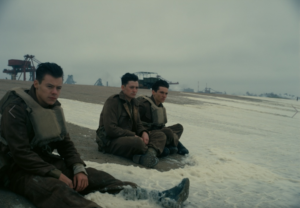
A Masterpiece on All Fronts
The Battle of Dunkirk is not as well known to average Americans compared to other WWII battles such as D-Day or the Battle of the Bulge. That is probably because no Americans fought in Dunkirk and it was not a great military victory, but a desperate evacuation. Still, without the heroism displayed by the Allied soldiers and many ordinary citizens, there wouldn’t have been a D-Day, and perhaps not even Europe as we know it. It’s about time this critical battle and those who bravely risked their lives to literally preserve the free world received their just due in the new movie, Dunkirk. Written and directed by Christopher Nolan, this historical war epic is undeniably a masterpiece and is unlike any war movie you have seen.
The film opens in a deserted French coastal town with leaflets raining down from the sky. British soldiers pick up the leaflets and read the messages from the German side. The Germans have surrounded the British and French against the ocean and will accept surrender. These soldiers come under fire, but only one named Tommy (Fionn Whitehead in his film debut) escapes to the beach. From his point of view, we see the hopeless situation – 400,000 soldiers stuck on the beach with few ships to carry them while German planes and U-boats are waiting. Making matters worse, the naval commander (Kenneth Branagh), who is leading the beach evacuation, learns that the Brits cannot spare more ships for the rescue as they are needed to defend against the invasion of England itself.
From here, Christopher Nolan presents the story from three different vantage points to illustrate the battle: the mole, the sea, and the air. The “mole” focuses on the men stranded on the beach trying to avoid German bombs and gunfire while hoping for safe passage on a ship. Plus, they must wait for the tides to rise enough to let the ships get close to shore. For the scenes in the mole, audiences follow teenage soldier Tommy and his friends who struggle to stay alive.
The second front in the film is the sea, which begins across the English Channel and follows the actions of the ordinary British citizens who owned small boats. These boats were commandeered by the Navy for the rescue operation, and those aboard risked their lives to travel to France to pick up the stranded soldiers. The main protagonists from this front are an elderly father (Mark Rylance, BFG, 2016) with his young son and friend who sail a small vessel across the sea to rescue anyone they can.
The final front is the air and follows the actions of royal air force pilots Farrier (Tom Hardy (The Revenant, 2015) and Collins (Jack Louden, Denial, 2016), who take off from Britain to shoot down German howitzer planes that are bombing the ships and beaches. Although they are outnumbered in the sky, the pilots refuse to abandon the people both on the ground and in the ships who are helpless to enemy fire. Over the course of the film, the events from all three fronts converge as we follow the brave individuals who fought the ultimate life-or death race against time.
Dunkirk may be Christopher Nolan’s best work, which is no small feat for such a talented director. The movie is visually stunning, filmed in a way that is sure to get Oscar attention and is underscored by a gripping score from the legendary Hans Zimmer. What sets Nolan’s direction and script in Dunkirk apart from other war movies are what he does not do. For example, other than some introductory text and some quick commentary from officers, the audience doesn’t get a huge preamble and explanation of the situation because we really don’t need it. We see the people on the beaches, we see the despair and fear in their eyes, and we can immediately connect the dots. There is also little blood and gore, which may surprise some considering it’s a war film. Additionally, outside of the German airplanes, the audience rarely sees the enemy, the German forces. In Dunkirk, the enemy is under water and in the sky, and not knowing where the enemy is intensifies the suspense. Another differentiating factor of Dunkirk, is the lack of dialogue, which only adds to the unknown, further heightening the suspense. You can sense these soldiers are terrified. They expect to die, and there are few words for that kind of circumstance. The audience may not get to know them as well as characters in other movies, but this isn’t a movie about character development. It is simply about survival. Finally, Christopher Nolan who is known for his long running times, kept this movie to under two hours, which is very rare for a war movie, but appropriate given the uninterrupted intensity of the movie.
In addition to the terrific narrative structure, sound, and visuals, the ensemble cast didn’t miss a beat either. Oscar-winner Mark Rylance was fantastic in his role and the heart of the movie as an ordinary citizen with unbelievable courage. Tom Hardy, although not given many lines and having his face covered a majority of the time (as in most films) is great as the ace pilot and ostensibly serves as the action hero. Finally, Kenneth Branagh, an actor best known for Shakespearean roles, is fantastic as the stoic naval commander who leads the evacuation from the “mole” with very few resources. Along with the veteran actors who lead the movie’s events, a crew of young actors (most making their film debut) are all solid in their roles as soldiers, including Fionn Whitehead, Tom-Glynn Garter, and a very capable performance by the British pop star, Harry Styles.
Bottom Line: Dunkirk will easily be considered one of the best films of 2017 and will no doubt receive Oscar attention. If you are a fan of film, it is worth seeing in IMAX or on a 70mm screen.
Credits: Written and directed by Christopher Nolan
Cast: Mark Rylance (Mr. Dawson), Tom Hardy (Farrier), Fionn Whitehead (Tommy), Tom Glynn-Garter (Peter), Harry Styles (Alex), Aneurin Barnard (Gibson), Kenneth Branagh (Commander Bolton), Cillian Murphy (shivering soldier)
Studio: Warner Brothers
Running Time: 106 minutes
Jessica DeLong © July 21, 2017
